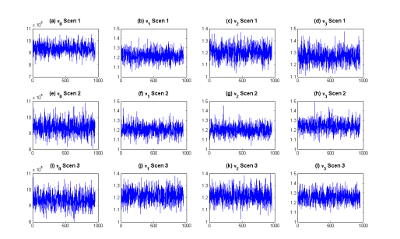
NeuroMat researcher develops Bayesian models to make sense of brain patterns in EEGs
Oct 01, 2014
The challenge of developing Bayesian statistical models to make sense of brain patterns registered in Electroencephalograms (EEGs) is the ongoing effort of the Research, Innovation and Dissemination Center for Neuromathematics (CEPID NeuroMat) post doctoral fellow Michelle Ferreira Miranda. Her research is being conducted in a partnership with neuroscientists of the Institute of Neurology Deolindo Couto, from the Federal University of Rio de Janeiro (INDC/UFRJ), who are also part of the NeuroMat research team.
Data that has been used to the development of these Bayesian models come from EEGs in an experiment on rhythms and brain functioning. According to Miranda, Bayesian statistical models are the best possible methods to make inferences on “big data” that EEGs produce. A key aspect is that it is possible to compute prior information to the experiment, such as the known structure of the brain, and consequently avoid making unjustified assumptions, that would be required in classical statistical inferences.
At the INDC, scientists collect EEGs from volunteers who listen to rhythmic stimuli. The experiment has been approved by ethics committees and measures brain activity with 20 electrodes, with no damage or impact to the volunteer health.
 |
The work on making sense of EEG data with Bayesian models is an ongoing project that has become one of Miranda's task at NeuroMat. She has got her PhD degree at the University of North Carolina, Chapel Hill, in 2013, and has been working on the development of new approaches to dealing with neural data. “Data from EEGs can be classified as ‘big data’, i.e., a collection of data sets so complex and large, that we need to develop new methods, instead of relying on the traditional ones,” she explained. Moreover, as brain signals from EEGs are related to complex models, Bayesian statistics is a technique that provides results more efficiently than frequentist methods.
Miranda's ongoing work at NeuroMat relates to techniques she developed during her graduate studies. Her thesis, “Bayesian analysis of ultra-high dimensional neuroimaging data,” has dealt with brain data, specifically magnetic resonance images. In her opinion, it may be possible to adapt models she developed at that time to the current experiment with EEGs. In order to advance in this direction, Miranda depends on new technology design, including supercomputers, so to being able to work with data sets of high levels of complexity, requiring advanced processing capacity.
The experiment on rhythms with Bayesian models is part of a broader research agenda on neural functioning that involves other methods of data analysis. This experiment may bring evidence that perception relates to model selection, that is, the brain applies parsimonious models to external stimuli. This general understanding of neural functioning has been presented in “NeuroMat mathematical models yield basic clues to neural functioning”. One evidence to support such conjecture is a set of preliminary results that show that one is able to somewhat reproduce the structure of rhythmic stimuli just by making sense of what is shown on EEGs.
Link to paper
This piece is part of NeuroMat's Newsletter #8. Read more here
Share on Twitter Share on Facebook| NeuroCineMat |
|---|
|
Featuring this week: |
| Newsletter |
|---|
|
Stay informed on our latest news! |
| Follow Us on Facebook |
|---|




